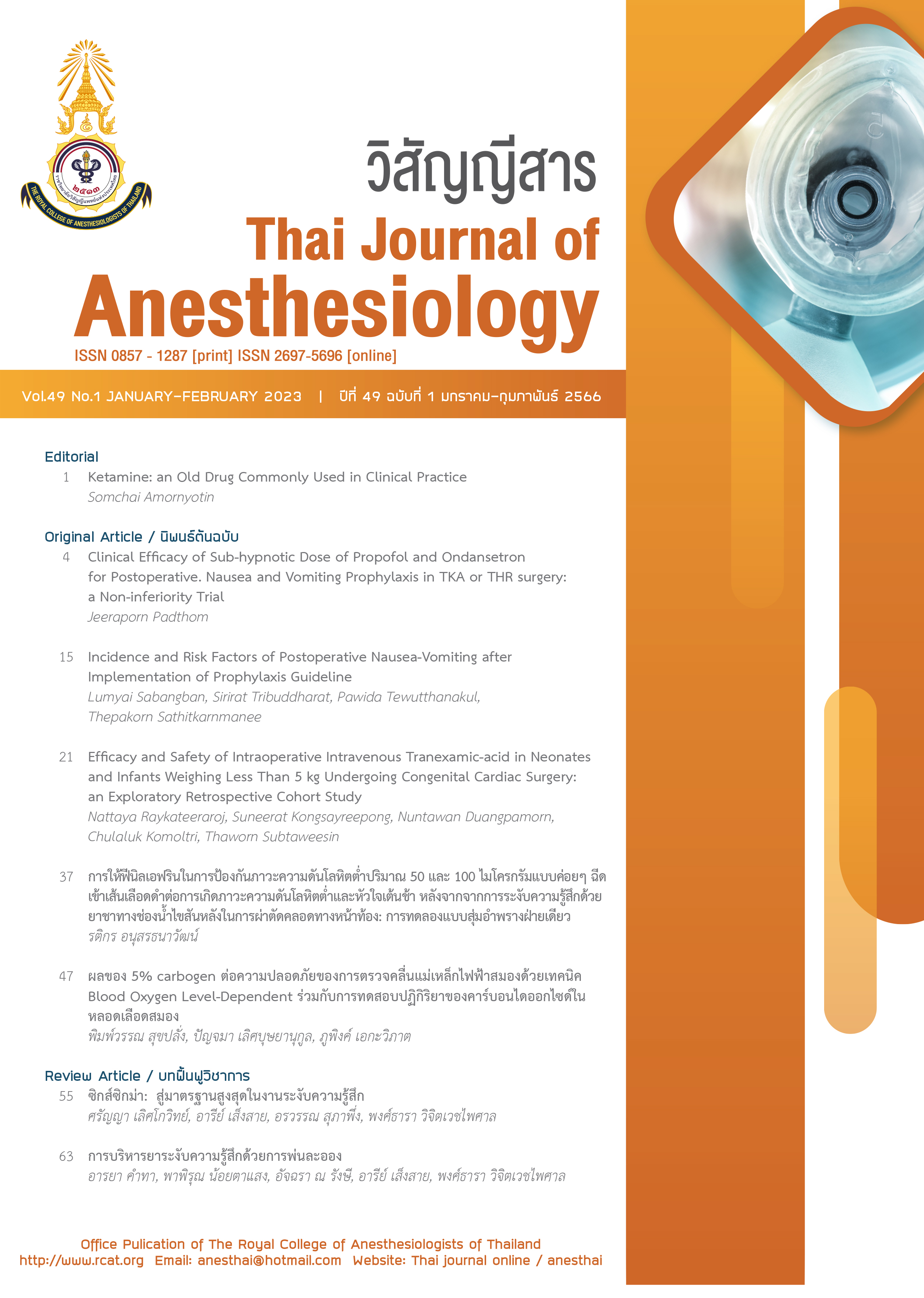การให้ฟีนิลเอฟรินในการป้องกันภาวะความดันโลหิตต่ำปริมาณ 50 และ 100 ไมโครกรัมแบบค่อยๆ ฉีดเข้าเส้นเลือดดำต่อการเกิดภาวะความดันโลหิตต่ำและหัวใจเต้นช้า หลังจากจากการระงับความรู้สึกด้วยยาชาทางช่องน้ำไขสันหลัง ในการผ่าตัดคลอดทางหน้าท้อง: การทดลองแบบสุ่มอำพรางฝ่า
Main Article Content
บทคัดย่อ
บทนำ: คำแนะนำระดับนานาชาติให้ใช้ยาฟีนิลเอฟรินในการป้องกันภาวะความดันโลหิตต่ำ โดยใช้วิธีเจือจางฉีดเป็นครั้งๆ และหรือใช้แบบต่อเนื่องด้วยเครื่องควบคุมการให้สารละลายทางหลอดเลือดดำในการจัดการภาวะความดันโลหิตต่ำจากการได้รับการระงับความรู้สึกด้วยยาชาทางช่องน้ำไขสันหลังในการผ่าคลอดทางหน้าท้อง แต่ในประเทศไทยมีข้อจำกัดด้านยา อุปกรณ์และการให้เพื่อการป้องกันยังไม่เป็นที่แพร่หลายมากนัก
วัตถุประสงค์: เพื่อเปรียบเทียบอัตราการเกิดภาวะความดันโลหิตต่ำ หัวใจเต้นช้าและอัตราการเกิดอาการข้างเคียงอื่นๆ จากการให้ยาฟีนิลเอฟรินแบบค่อยๆ ฉีดเข้าหลอดเลือดดำภายใน 30 วินาที ระหว่างปริมาณ 50 และ100 มคก. ในการป้องกันภาวะความดันโลหิตต่ำจากการระงับความรู้สึกด้วยยาชาทางช่องน้ำไขสันหลังในการผ่าตัดคลอดทางหน้าท้อง
วิธีการศึกษา: หญิงตั้งครรภ์ 62 รายที่มารับการผ่าตัดคลอดทางหน้าท้องแบบนัดล่วงหน้าระหว่างตุลาคม- ธันวาคม พ.ศ. 2564 ได้รับสารละลายเกลือแกงความเข้มข้นร้อยละ 0.9 พร้อมกับการระงับความรู้สึกด้วยยาชาบูพิวาเคน 2.2 มล. และมอร์ฟีน 0.2 มก.ทาง
ช่องน้ำไขสันหลัง ถูกแบ่งกลุ่มอย่างสุ่มออกเป็น 2 กลุ่ม คือ กลุ่ม P50 ได้รับยาฟีนิลเอฟริน 50 มคก. และกลุ่ม P100 ได้รับยาฟีนิลเอฟริน 100 มคก. ใน 10 มล. แบบค่อยๆ ฉีดเข้าหลอดเลือดดำภายใน 30 วินาที โดยเปิดข้อต่อฉีดยาทั้งสามทางให้สารละลายเกลือแกงค่อยๆนำยาเข้าสู่ร่างกายเพื่อเลียนแบบการทำงานของเครื่องควบคุมการให้สารละลายทางหลอดเลือดดำ รักษาภาวะความดันโลหิตต่ำด้วยยาฟีนิลเอฟริน 100 มคก. และหัวใจเต้นช้าด้วยยาอะโทรปีน 0.6 มก. และบันทึกอาการข้างเคียงอื่นๆ
ผลการศึกษา: พบภาวะความดันโลหิตต่ำในกลุ่ม P100 น้อยกว่ากลุ่ม P50 อย่างมีนัยสำคัญทางสถิติ (จำนวน19 ราย (ร้อยละ 61.3) กับ จำนวน 26 ราย (ร้อยละ 83.9), P=0.04) พบความแตกต่างอย่างไม่มีนัยสำคัญทางสถิติระหว่าง 2 กลุ่ม ในตัวแปรภาวะหัวใจเต้นช้าปริมาณฟีนิลเอฟรินที่ใช้รักษา ภาวะความดันโลหิตสูง หัวใจเต้นผิดจังหวะ คลื่นไส้อาเจียน และคะแนน Apgar ที่ 1 และ 5 นาที
สรุป: การให้ยาฟีนิลเอฟรินปริมาณ 100 มคก.ทางหลอดเลือดดำแบบป้องกันโดยค่อยๆ ฉีดภายใน 30 วินาที เปิดข้อต่อฉีดยาทั้งสามทางให้สารละลายเกลือแกงค่อยๆ พายาเข้าสู่ร่างกายเพื่อเลียนแบบการทำงานของเครื่องควบคุมการให้สารละลายทางหลอดเลือดดำ สามารถลดอุบัติการณ์การเกิดภาวะความดันโลหิตต่ำได้ดีกว่า 50 มคก. โดยไม่พบอาการข้างเคียงรุนแรงอื่นๆในหญิงตั้งครรภ์ที่ได้รับการระงับความรู้สึกด้วยยาชาทางช่องน้ำไขสันหลัง
ในการผ่าตัดคลอดทางหน้าท้อง
Article Details

อนุญาตภายใต้เงื่อนไข Creative Commons Attribution-NonCommercial-NoDerivatives 4.0 International License.
เอกสารอ้างอิง
Ohpasanon P, Chinachoti T, Sriswasdi P, Srichu S. Prospective study of hypotension after spinal anesthesia for cesarean section at Siriraj Hospital: incidence and risk factors, Part 2. J Med Assoc Thai. 2008;91:675-80.
Somboonviboon W, Kyokong O, Charuluxananan S, Narasethakamol A. Incidence and risk factors of hypotension and bradycardia after spinal anesthesia for cesarean section. J Med Assoc Thai. 2008;91:181-7.
Russell IF. Spinal anaesthesia for caesarean section. The use of 0.5% bupivacaine. Br J Anaesth. 1983;55:309-14.
Saravanan S, Kocarev M, Wilson RC, Watkins E, Columb MO, Lyons G. Equivalent dose of ephedrine and phenylephrine in the prevention of post-spinal hypotension in Caesarean section. Br J Anaesth. 2006;96:95-9.
Anusorntanawat R. Incidence and risk factors associated with spinal anesthesia induced predelivery hypotension for cesarean section. Region 4-5 Med J. 2015;34:267-79.
Tan HS, Habib AS. The optimum management of nausea and vomiting during and after cesarean delivery. Best Pract Res Clin Anaesthesiol. 2020;34:735-47.
Kinsella SM, Carvalho B, Dyer RA, et al. International consensus statement on the management of hypotension with vasopressors during caesarean section under spinal anaesthesia. Anaesthesia. 2018;73:71-92.
นวัตกรรมวิสัญญี. [cited 27 สิงหาคม 2562]. Available from: http://ndi.fda.moph.go.th/drug_detail/index/?ndrug=5&rctype=1C&rcno=6215031&lpvncd=&lcntpcd=&lcnno=&licensee_no=.
Uerpairojkit K, Anusorntanawat R, Sirisabya A, Chaichalothorn M, Charuluxananan S. Neonatal effects after vasopressor during spinal anesthesia for cesarean section: a multicenter, randomized controlled trial. Int J Obstet Anesth. 2017;32:41-7.
Fitzgerald JP, Fedoruk KA, Jadin SM, Carvalho B, Halpern SH. Prevention of hypotension after spinal anaesthesia for caesarean section: a systematic review and network meta-analysis of randomised controlled trials. Anaesthesia. 2020;75:109-21.
Anusorntanawat R. A comparison of phenylephrine administration between intravenous bolus and slow injection in treatment of spinal anesthesia-induced hypotension on bradycardia and other side effects in patients undergoing cesarean section: a randomized, single-blind study. Thai J Anesthesiol. 2020;46:80-7.
Anusorntanawat R, Uerpairojkit K, Thongthaweeporn N, Charuluxananan S. Safety of phenylephrine in antihypotensive treatment during spinal anesthesia for cesarean section. J Med Assoc Thai. 2016;99:188-96.
Sharwood-Smith G, Drummond GB. Hypotension in obstetric spinal anaesthesia: a lesson from pre-eclampsia. Br J Anaesth. 2009;102:291-4.
Langesaeter E, Rosseland LA, Stubhaug A. Continuous invasive blood pressure and cardiac output monitoring during cesarean delivery: a randomized, double-blind comparison of low-dose versus high-dose spinal anesthesia with intravenous phenylephrine or placebo infusion. Anesthesiology. 2008;109:856-63.
Lee JE, George RB, Habib AS. Spinal-induced hypotension: incidence, mechanisms, prophylaxis, and management: summarizing 20 years of research. Best Pract Res Clin Anaesthesiol. 2017;31:57-68.
Farkas A, Dempster J, Coker SJ. Importance of vagally mediated bradycardia for the induction of torsade de pointes in an in vivo model. Br J Pharmacol. 2008;154:958-70.
นวัตกรรมวิสัญญี Left uterine displacement for cesarean section [Internet] [Cited 29 December 2021]. Available from: https://www.youtube.com/watch?v=ryyESPZ_2hU.
Lirk P, Haller I, Wong CA. Management of spinal anaesthesia-induced hypotension for caesarean delivery: a European survey. Eur J Anaesthesiol. 2012;29:452-3.


